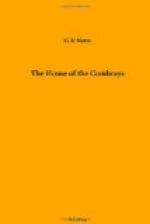CHAPTER VI
THE YELLOW HORSE
The man in the “black overcoat” who had conducted the gendarmes on their visit to Donnay, was no other than “Grand-Charles,” one of Allain’s followers. He had been arrested at Le Chalange on July 14th, and had consented without hesitation, to show the spot in the Buquets’ garden where the money had been hidden. He recognised the position of the house and garden, the room in which Allain and his companions had been received on the night of the robbery, and even the glass which Mme. Buquet had filled for him. At the bottom of the garden traces of the excavation that had contained the money were found; the loft contained linen, and other effects of Mme. Acquet; her miniature was hanging on the wall of Joseph’s room. Joseph alone had fled; his father, mother, and brother were taken to prison in Caen the same evening.
“Grand-Charles,” who did not want to be the only one compromised, showed the greatest zeal in searching for his accomplices. As Querelle had done before, he led Manginot and his thirty gendarmes over all the country, until they reached the village of Mancelliere, which passed as the most famous resort of malcontents in a circuit of twenty leagues. As in the happiest days of the Chouan revolt, there were bloody combats between the gendarmes and the deserters. After one of these engagements Pierre-Francois Harel,—who had passed most of his time since the Quesnay robbery in a barrel sunk in the earth at the bottom of a garden—was arrested in the house of a M. Lebougre, where he had gone to get some brandy and salt to dress a wound. But Manginot made a more important capture in Flierle, who was living peacefully at Amaye-sur-Orne, with one of his old captains, Rouault des Vaux. Flierle told his story as soon as he was interrogated; he knew that “high personages” were in the plot, and thought they would think twice before pushing things to an issue.




